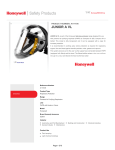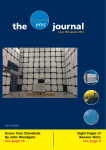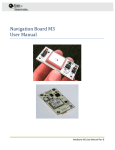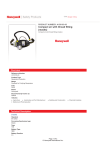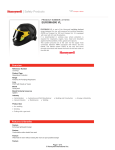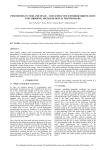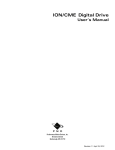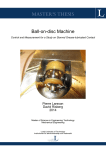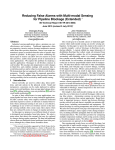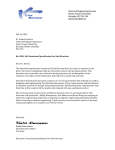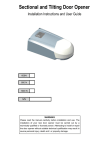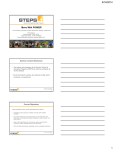Download Functional Specifications
Transcript
5562 Balsam Street • Vancouver, BC • V6M 4B7 • 604-726-4171 February 16th, 2015 Dr. Andrew Rawicz School of Engineering Science Simon Fraser University Burnaby, British Columbia V5A 1S6 Re: ENSC 440 Functional Specification for the Musical Rehabilitation Assistance System Dear Dr. Rawicz: Find attached the Functional Specification document for the Musical Rehabilitation Assistance System (MRAS), our project for ENSC 440 – Capstone Engineering Science Project. We intend to design and build a system for rehabilitation patients, which will provide auditory and visual feedback while they learn to walk again. The purpose of the system is to assist both the therapist and the patient in the rehabilitation process. This functional specification gives an overview of the MRAS functionality. It defines the requirements from proof-of-concept through to the final production for the system as a whole, as well as the MRAS subsystems. It also lays out test plans for all phases of the product development. Harmony Innovation is a partnership of five late-term engineering science students: - James Thomson, Engineering Physics - Sam Chu, Electronics Engineering - Ryan Colter, Computer Engineering - Elnaz Heidari, Systems Engineering - Adam Prochazka, Systems Engineering If you have any questions or concerns about our proposal, please feel free to contact at [email protected]. Sincerely, James Thomson Project Manager Harmony Innovation ENCLOSED: Functional Specification for the Musical Rehabilitation Assistance System Functional Specification for the Musical Rehabilitation Assistance System Project Partnership: James Thomson Sam Chu Ryan Colter Elnaz Heidari Adam Prochazka Contact Person: James Thomson [email protected] Submitted to: Dr. Andrew Rawicz (ENSC 440) Steve Whitmore (ENSC 305) School of Engineering Science Simon Fraser University Submission date: February 16th, 2015 Version: 1.0 Functional Specification for the MRAS EXECUTIVE SUMMARY No one decides to give up the ability to walk. Whether through injury or illness, losing that most human of abilities is a devastating blow. A significant amount of time and effort is put into rehabilitating those who have a chance to regain the use of their legs. Patients and therapists deserve to be rewarded for the work they do, in real time. The Musical Rehabilitation Assistance System (MRAS) by Harmony Innovation aims to do just that. We want to be there, cheering them on for every step; we want to be the soundtrack to their rehabilitation. The MRAS will be developed first as a proof-of-concept, and later refined to its final production model. For the proof-of-concept, the system will consist of an Electronics component, a Kit component and a Software component. The Kit will facilitate attaching the Electronics to the patient. The Electronics will use a series of Modular Sensor Units to read the position and velocity of the patient’s limbs. These data will be gathered by a Controller, which will transmit them to a personal computer running our Software. After analysis, the Software will return an auditory feedback to the patient in accordance with the quality of their movements. As the patient improves their ability to walk, the MRAS will increase the quality of the feedback. Harmony Innovation will test and refine the MRAS throughout the Development, Integration and Testing phases. Our goal is to deliver the finished proof-of-concept by April 10th, 2015. For the final production model, the Software will be bundled into a mobile application that can be run on a Smartphone or other similar mobile devices. The Kit will be refined to better suit the needs of patients and therapists, and will adjust along with the Electronics to be more discrete and less encumbering. The Electronics will go from a prototype design to a mass-production design to reduce cost and meet demand. The MRAS will be designed to conform to all regulatory standards and guidelines, including those defined by the Canadian Standards Association and the American National Standards Institute. ii Copyright © 2015, Harmony Innovation Functional Specification for the MRAS TABLE OF CONTENTS Executive Summary .................................................................. ii List of Figures .........................................................................iv Glossary................................................................................. v 1. Introduction ........................................................................ 1 1.1 Scope ............................................................................................1 1.2 Intended Audience ...........................................................................1 1.3 Classification...................................................................................1 2. System Overview .................................................................. 2 3. System Requirements ............................................................ 5 3.1 3.2 3.3 3.4 3.5 3.6 3.7 General Requirements.......................................................................5 Environmental Requirements ..............................................................5 Standards .......................................................................................5 Reliability and Durability....................................................................5 Safety Requirements .........................................................................5 Performance Requirements ................................................................6 Usability Requirements......................................................................6 4. Electronics Requirements ....................................................... 7 4.1 General Requirements.......................................................................7 4.2 Physical Requirements ......................................................................8 5. Kit Requirements.................................................................. 9 5.1 General Requirements.......................................................................9 5.2 Physical Requirements ......................................................................9 6. Software Requirements .........................................................10 6.1 General Requirements..................................................................... 10 6.2 Physical Requirements .................................................................... 10 7. User Documentation .............................................................11 7.1 General Requirements..................................................................... 11 iii Copyright © 2015, Harmony Innovation Functional Specification for the MRAS 8. System Test Plan .................................................................12 8.1 8.2 8.3 8.4 Electronics Testing ......................................................................... 12 Kit Testing.................................................................................... 12 Software Testing ............................................................................ 13 System Testing .............................................................................. 13 9. Safety and Sustainability Analysis ............................................15 10. Conclusion .......................................................................16 11. References .......................................................................17 LIST OF FIGURES Figure 1: High level graphic model of the MRAS ............................................2 Figure 2: High level functional diagram of the MRAS ......................................3 Figure 3: MRAS development plan with milestones ...................................... 12 iv Copyright © 2015, Harmony Innovation Functional Specification for the MRAS GLOSSARY Active Data Data acquired by the Software in the run state during therapy. This data is generated by the patient during therapy and is compared to the baseline data. Ambulate To move from place to place, walk. Commonly used in the medical community. From the Latin root ambulare. [1] Analytic Algorithm A Linear Discriminant Analysis algorithm, developed by Sir Ronald Fisher, “to find a linear combination of features which characterizes or separates two or more classes of objects or events”. [2] ANSI American National Standards Institute. Baseline Data Data acquired by the Software in calibration state. This data is generated with the assistance of the therapist and is stored as the point of reference during therapy. Calibration State State of the Software at start of a therapy session. In this state, the Software acquires baseline data. Controller Arduino microcontroller, Bluetooth plugin adapter, battery, status LEDs, switches, and its enclosure. CSA The Canadian Standards Association. Electronics All electronics in or attached to the MRAS. This includes the MSUs and the Controller. IMU Inertial Measurement Unit: the integrated circuit that measures rotation, acceleration, and more. Kit All parts of the MRAS used to connect to the patient. This includes the vest, sensor straps, and housings for all electronics. LED Light-Emitting Diode: low power lights for status indication on the Controller. MIDI Musical Instrument Digital Interface: a technical standard that describes a protocol, digital interface and connectors and allows a wide variety of electronic musical instruments, computers and other related devices to connect and communicate with one another. [3] MRAS Musical Rehabilitation Assistance System. MSU Modular Sensor Unit: includes sensors, circuitry to connect to data and power ports, and the MSU input port. v Copyright © 2015, Harmony Innovation Functional Specification for the MRAS MSUIP MSU Input Port: the receiving port of the 1/8th inch audio receiving port. Patient A generic term used to identify the individual receiving therapy. The patient is between 150-200 cm (5’0”-6’6”) tall. PC A personal computer running a Microsoft Windows operating system, with the necessary peripheral software to execute the Analytic Algorithm. Run State State of the Software during an active therapy session. In this state, the Software collects active data for comparison to baseline data and generates feedback. Software All programs needed to operate the MRAS. This includes the Analytic Algorithm software, the Controller firmware, the MIDI Controller and Sample Library. Spec/Speccing Referring to specifications of a particular component. Strap Fabric bands used to attach the MSU to the patient. Therapist A generic term used to identify the individual administering therapy. This may include physiotherapists, nurses, doctors, recreational therapists, rehabilitation therapists, or any similar medical professional. vi Copyright © 2015, Harmony Innovation Functional Specification for the MRAS 1. INTRODUCTION The Musical Rehabilitation Assistance System (MRAS) is a medical system designed to help therapists and patients during the rehabilitation process. The MRAS helps provide feedback for both the therapist and the patient, which will help accelerate the recovery period so patients can quickly get back on their feet. This functional specification document will outline the requirements for the MRAS as proposed by Harmony Innovation. 1.1 Scope The functional specifications in this document will describe the requirements that are met by the MRAS. These specifications will act as the roadmap for the proof-ofconcept of the MRAS, and it help to drive the design. These design implications will be traced for future revisions. 1.2 Intended Audience This document will serve as a guideline for all company members, design and test engineers. Project management will refer to this document to track the progress during the developmental phase of the MRAS. The test plan will outline design and testing requirements for engineers to follow. The design and testing of the MRAS must adhere to these requirements to ensure the safety of others and ensure the product will be reliable for therapists and patients to use. 1.3 Classification The requirements stated throughout the functional specification will follow the convention [Rx.y.z-w] where x is a number that denotes the requirement group, y is a number that denotes the subgroup, z is a number that denotes the subgroup requirement number, and w is a letter that indicates the priority such that: A P F The requirement applies to all iterations of the system. The requirement applies to the proof-of-concept system only. The requirement applies to the final production system only. 1 Copyright © 2015, Harmony Innovation Functional Specification for the MRAS 2. SYSTEM OVERVIEW The MRAS is designed to help therapists and patients through the use of feedback to help reduce recovery time. Figure 1 shows a graphic model of the MRAS. The system is separated into three distinct parts; the Electronics, the Kit, and the Software. Figure 2 shows a high-level functional diagram of the MRAS. The Electronics are nested within the Kit, which is attached to the patient by the therapist. The therapist puts the Software into a calibration state and then moves the patient’s arms and legs to acquire baseline data. The therapist then puts the Software into a run state, and the patient generates active data while attempting to replicate the motion. For each limb, the Software analyses the active data, compares it to the baseline data, and responds with an appropriate feedback. As the patient’s active data more and more resembles the baseline data, the quality of the feedback improves, either by pitch modulation, tempo adjustment, or volume control. Each limb controls a unique part of the feedback, which means that, as the patient achieves synchronous motion of the limbs, the music plays back in its most complete and unaltered form. Similarly, if a particular part of the arrangement is not heard or is out of tune, it clearly identifies which limb requires more attention. Figure 1: High level graphic model of the MRAS 2 Copyright © 2015, Harmony Innovation Functional Specification for the MRAS Our project will include the research and development of a tool that will provide auditory feedback to patients undergoing rehabilitation and to the therapists administering the process. Currently, a patient would perform a certain motion or series of motions as instructed by a therapist. The result is the performance of the action, successful or unsuccessful, and the response of the therapist. Our product adds automated feedback to the process, in the form of music, to assist in the learning process. This tool will be especially helpful for patients who choose to supplement their rehabilitation independently and will provide direct feedback based on the movements taught by the therapist. Figure 2: High level functional diagram of the MRAS The MSU uses a 9-axis sensor with a built in gyroscope, accelerometer, and magnetometer. MSUs are attached on each of the limbs and joint areas as shown in Figure 1. By using these types of sensors instead of standalone accelerometers and gyroscopes, we reduce the number of components per MSU and allow room for additional features in future revisions. Another advantage of using a single IMU over multiple sensors per MSU is improved consistency in data; issues with data being synced between multiple sensors and MSUs could otherwise occur. Each MSU will be connected to the Controller, which will then communicate via Bluetooth to a PC. Bluetooth is used because it is widely supported by many electronics. The Controller, an Arduino Mega ADK, provides all the required input and output ports to support our data lines from each MSU simultaneously. The Mega model is chosen over the UNO model because of extra inputs, which is not necessary due to MSU and Controller serial data transfer capabilities, to reduce the complexity of the proof-of-concept design. This particular controller is also quite small and light, which is an advantage for a wearable product. Standard 9V batteries will be used to power all of the Electronics in the proof-of-concept design for at least one hour as specified in the battery specifications. Future revisions will include rechargeable battery packs that can be easily installed, swapped and charged. For the proof-of-concept, the Kit will 3 Copyright © 2015, Harmony Innovation Functional Specification for the MRAS communicate using Bluetooth with a PC. The data transferred via Bluetooth from the Controller to the PC will be fed into Matlab. An Analytic Algorithm will run in Matlab software. The Algorithm will analyze the transferred data, and output results to the MIDI Controller, which will play back the appropriate sounds. For the final production model, the Software will be packaged into an application suitable for mobile use. This Software can then be installed onto a Smartphone, tablet, or any similarly powerful Bluetooth-enabled device. This will remove the need for a PC, which reduces the cost to the owner of the MRAS, and increases the range of the MRAS by eliminating the need of proximity to a PC for receiving feedback. 4 Copyright © 2015, Harmony Innovation Functional Specification for the MRAS 3. SYSTEM REQUIREMENTS This section lists the general requirements applicable to the MRAS as a rehabilitation system. 3.1 General Requirements [R3.1.1-A] [R3.1.2-F] [R3.1.3-A] [R3.1.4-F] The system will have an idle state where all adjustable parts are locked and static. The retail price of the system shall be under CDN$500. The system shall be silent when it is inactive. The therapist shall be the intended operator of the system. 3.2 Environmental Requirements [R3.2.1-A] [R3.2.2-F] [R3.2.3-F] [R3.2.4-A] [R3.2.5-A] [R3.2.6-F] The device shall be used in an indoor environment. The device shall be used only in standard dry-land rehabilitation conditions. Noise generated during active periods shall be minimized or controlled via personal audio devices, such as headphones. Playback volume shall be controlled by the user, but should not exceed 85 dB in order to prevent harm to the patient’s hearing. The device shall be operated at room temperatures of 22-27 ºC to prevent damage. The device shall be operated in a clinical setting with humidity between 30-50% to prevent damage. 3.3 Standards [R3.3.1-F] [R3.3.2-F] [R3.3.3-F] The product shall meet ANSI standards. The device shall conform to “Application of Usability Engineering to Medical Devices” IEC 62366. [4] The system will conform to the guideline for administrative, medical and nursing staff concerned with the safe use of medical electrical equipment and medical systems IEC/TR 60930 Ed. 2.0 en. [5] 3.4 Reliability and Durability [R3.4.1-F] [R3.4.2-F] [R3.4.3-A] [R3.4.4-A] The components shall be able to withstand regular patient use. The system shall be serviceable by trained technicians. The system shall not be exposed to complete liquid immersion. Excess moisture contacting the system shall be immediately removed. 5 Copyright © 2015, Harmony Innovation Functional Specification for the MRAS 3.5 Safety Requirements [R3.5.1-A] [R3.5.2-A] [R3.5.3-A] [R3.5.4-F] The system shall not cause bodily harm to patient while in use. The system shall not spontaneously combust. The electronic components and power connections shall be enclosed. The electronic components shall not cause interference with other devices. 3.6 Performance Requirements [R3.6.1-F] [R3.6.2-F] [R3.6.3-F] The system shall register active data within 250 ms while in use. The system shall deliver feedback for active data within 500ms. The system shall monitor battery life and produce a warning when low battery is detected. 3.7 Usability Requirements [R3.7.1-A] [R3.7.2-A] [R3.7.3-F] [R3.7.4-A] [R3.7.5-F] The system shall acquire and analyze data when the therapist has first correctly equipped the Kit on the patient and the Software is in calibration or run state. The system shall provide feedback when the therapist has first correctly equipped the Kit on the patient and the Software is in run state. The Kit and Electronics shall not exceed 2 kg in order to be light enough not to impede the patient. The heat output from the system shall not affect the comfort of the patient. The Software will be provided and upgradeable remotely by the user. 6 Copyright © 2015, Harmony Innovation Functional Specification for the MRAS 4. ELECTRONICS REQUIREMENTS This section lists the requirements for the MRAS Electronics subsystem, including MSUs, the Controller, wiring, and junctions. 4.1 General Requirements [R4.1.1-P] [R4.1.2-P] [R4.1.3-F] [R4.1.4-P] [R4.1.5-A] [R4.1.6-P] [R4.1.7-A] [R4.1.8-A] [R4.1.9-F] [R4.1.10-A] [R4.1.11-F] [R4.1.12-A] [R4.1.13-A] [R4.1.14-P] [R4.1.15-P] [R4.1.16-P] [R4.1.17-A] [R4.1.18-A] [R4.1.19-F] [R4.1.20-F] [R4.1.21-A] [R4.1.22-A] [R4.1.23-A] [R4.1.24-A] [R4.1.25-F] [R4.1.26-A] Sensor data will transfer from each MSU to Software via Controller. Each MSU will be attached to a strap. Each MSU will be contained inside a strap, with only its MSUIP visible and accessible. Each MSU shall be identically implemented on the Kit. Each MSU will be powered by the Controller. Each MSU shall measure an acceleration up to 6g. [6] The Controller shall provide sufficient power to each MSU simultaneously. The Electronics shall be minimally intrusive to the user. A portable self-sufficient power source shall be sufficient to provide energy for all Electronics simultaneously. The power adapter shall be usable with a wall supply of 110V/120V at 60 Hz AC, which is typical of North American wall outlets. The attached cord for the power adaptor shall have a length no less than 3m. The power cord shall be removable. The control box shall have an identifiable ON/OFF switch. The control box shall have calibration state indicator LEDs. The control box shall have calibration state LEDs and state switches. All sensors will operate at 0.0-3.6V. [7] The Controller will receive 7-12V of voltage during normal operation. [8] The entire system shall be able to operate at full capacity for a minimum of 1 hour. The portable self-sufficient power source shall be accessible for replacement. The portable self-sufficient power source shall be operational for at least 5 years before requiring replacement. Wiring runs shall be housed in protective cladding. Junction between Controller and MSUs will be implemented via electrical disconnect. MSU and Controller junction ports will be female and of the same type. Electrical components will be fused to their appropriate specifications. MSU shall be functional after a fall of 160cm. The Controller shall have an interface for external connection with a PC for diagnostic purposes. 7 Copyright © 2015, Harmony Innovation Functional Specification for the MRAS [R4.1.27-P] The Controller will communicate with the Software wirelessly using the standard Bluetooth protocol. 4.2 Physical Requirements [R4.2.1-F] Each MSU may be omitted from the MRAS. 8 Copyright © 2015, Harmony Innovation Functional Specification for the MRAS 5. KIT REQUIREMENTS This sections lists the requirements for the MRAS Kit subsystem, including vest, straps, and enclosures. 5.1 General Requirements [R5.1.1-A] [R5.1.2-A] [R5.1.3-A] [R5.1.4-A] [R5.1.5-A] [R5.1.6-A] [R5.1.7-A] All materials that come in contact with the patient will be hypoallergenic. All fabric materials will be washable and reusable. All wrist straps will be adjustable and will fit a 10-25cm circumference. All upper mid-arm straps will be adjustable and will fit a 20-45cm circumference. All thigh straps will be adjustable and will fit a 40-85cm circumference. All ankle straps will be adjustable and will fit a 15-35cm circumference. Enclosures shall be made from recycled or recyclable material. 5.2 Physical Requirements [R5.2.1-F] [R5.2.2-P] [R5.2.3-P] [R5.2.4-A] [R5.2.5-F] [R5.2.6-F] [R5.2.7-F] The Kit shall be resistant to breakage under normal operating conditions. The system shall accommodate individuals from 150-200cm. The vest shall be similar in size and shape to a Honeywell TV15RSC traffic vest. [9] The vest shall fit various body types and not hinder performance. MSU enclosure must sustain minimal damage after a fall of 160cm. MSU enclosure must sustain minimal damage from an impact force of 600N or less. The Kit shall be resistant to electronic and mechanical damage caused by moisture. 9 Copyright © 2015, Harmony Innovation Functional Specification for the MRAS 6. SOFTWARE REQUIREMENTS This section lists the requirements for the MRAS Software subsystem, including the Analytic Algorithm, MIDI Controller, and Sample Library. 6.1 General Requirements [R6.1.1-P] [R6.1.2-F] [R6.1.3-A] [R6.1.4-A] [R6.1.5-A] The Software will run natively in a Windows PC environment. The Software will run natively on Apple and Android mobile devices. The Software will collect data from the Controller. The Software will store baseline data for comparison with active data. The Software will provide functionality for acquiring, storing and deleting baseline data. [R6.1.7-A] The Software will provide functionality for monitoring active data. [R6.1.8-A] The MIDI Controller and Sample Library shall be provided with the system. [R6.1.9-F] The Sample Library shall be customizable. [R6.1.10-F] The music used by the MIDI Controller shall be customizable. 6.2 Physical Requirements [R6.2.1-A] [R6.2.2-F] The Software will be made available via portable media device (USB, DVD, CD). The Software will be made available via digital download. 10 Copyright © 2015, Harmony Innovation Functional Specification for the MRAS 7. USER DOCUMENTATION This section lists the requirements for the MRAS User documentation. 7.1 General Requirements [R7.1.1-F] [R7.1.2-F] [R7.1.3-F] [R7.1.4-F] User documentation shall include a website with general and technical support information and a user manual, both written in English. The user manual shall be written for the therapist overseeing the use of the system. User documentation shall be provided in multiple languages based on territorial adoption. A detailed installation guide for therapists shall be created. 11 Copyright © 2015, Harmony Innovation Functional Specification for the MRAS 8. SYSTEM TEST PLAN In order to properly test the MRAS, testing will be performed during the Development, Integration and Testing phases. Figure 3 shows the current project schedule. Figure 3: MRAS development plan with milestones 8.1 Electronics Testing Testing at the outset of the Development phase will focus on verification of individual parts. By checking that they are functionally sound, we reduce the likelihood of issues due to component failure. As parts are assembled into subsystems, functional testing will continue to ensure that there is good current flow between the MSU and the Controller. During the Integration phase, testing will focus on the communication of data between the Electronics and Software. Initial tests will verify that signal is being sent wirelessly to the Software. Subsequent testing will revolve around the quality of the data being sent to reduce the signal-to-noise ratio where possible. 8.2 Kit Testing Kit testing will be primarily done in conjunction with other parts. The concerns for the Kit are durability, comfort and integration with the Electronics. During Development, 12 Copyright © 2015, Harmony Innovation Functional Specification for the MRAS testing will ensure that the straps meet size requirements, and that the straps will survive regular use and cleaning. During Integration, Kit testing will revolve around housing the Electronics and ensuring that the MSUs and Controller are easy to nest and remove. 8.3 Software Testing During the Development phase, Software testing will begin by inputting dummy values into the analytic algorithm to ensure that there is output for a single data channel. Further testing will refine the inputs to tune the output values to produce the desired MIDI signal. This output will then be routed into the MIDI Controller, which will receive the signal, communicate with the sound library, and send the appropriate sound to the speakers. As the Software is refined, the number of data channels will increase, and testing will focus on ensuring separation between sensor channels and that playback is correct for each channel. Integration testing will remove the dummy input data and replace it with the wireless signal from the Controller. This is to ensure that MSU signals pass through the Controller to the Analytic Algorithm, then to the MIDI Controller and out to the Speakers. 8.4 System Testing At the end of the Integration phase, it is expected that the Electronics, Kit and Software are all functional and that there is basic marriage between them. Entering the Alpha Testing phase, the focus will be on tuning the data stream so that the outputs align with expectations. A standard user path will be defined based on communication with therapists in the target market. The MRAS will then be tested along the standard user path to identify common sources of error. Changes to the system, as well as additions, will be allowed during this phase. Issues will be tracked and resolved based on priority and severity. System testing will also be used to verify the optimal positioning of the MSU on each limb. The following functional modes will be tested: - Each limb is moved independently to verify a complete signal path from the MSU to the speakers. - Limb pairs (arms or legs) are moved to verify that channel integrity is maintained. - All four limbs perform synchronous motion to ensure complete system functionality. - Acquisition of baseline data for four limb synchronous motion. 13 Copyright © 2015, Harmony Innovation Functional Specification for the MRAS - Acquisition of baseline data for three limb synchronous motion (amputee testing). - Acquisition of baseline data for synchronous motion of legs only (double amputee testing). The - following failure modes will be tested: Left arm is held static while the other limbs move normally. Right arm is held static while the other limbs move normally. Both arms swing in unison while the legs move normally. Both legs move in unison while the arms move normally (hopping). Active data collected by a limb where no baseline data exists. MSU enclosures will be dropped from a height of 160cm. Controller enclosure will be dropped from a height of 160cm. MSU enclosures will be subjected to an impact force of 600N. Controller enclosures will be subjected to an impact force of 600N. 14 Copyright © 2015, Harmony Innovation Functional Specification for the MRAS 9. SAFETY AND SUSTAINABILITY ANALYSIS The purpose of the MRAS project is to improve the patient’s quality of life through extra assistance in the rehabilitation process. Extensive measures must be taken to ensure that our system itself does not cause any harm or injury to the patient. Our safety analysis will look closely at both the electronic and cosmetic features of the design to avoid risk of any possible hazard to both patients and therapists. While picking electronic components, we are keeping in mind that the device is in close contact by the user. The placement of the wiring and other pieces on the vest are carefully thought out to avoid any disturbance to the patient or the therapist. From the early planning phase of MRAS, Harmony Innovation has considered integrating existing parts and components as well as recyclable materials. One of the focal issues is the use of batteries in the design. An improvement will be made in production by replacing the disposable power source with rechargeable batteries instead. Many of the components such as sensors and controllers purchased for this project can be used again in future prototypes and designs. The cradle-to-cradle design approach is in the agenda for the production phase and the appropriate certifications will be attained. 15 Copyright © 2015, Harmony Innovation Functional Specification for the MRAS 10. CONCLUSION This document defines the functional specifications and design requirements of the Musical Rehabilitation Assistance System. For each subsystem requirement and requirements for the system as a whole, priority is based on the safety and functionality of the final product. Development of the proof-of-concept model has already begun, and all features classified as priority P are expected to be fully functional the target date of April 10th, 2015. 16 Copyright © 2015, Harmony Innovation Functional Specification for the MRAS 11. REFERENCES [1] “Ambulate”, (2015, February 13). Merriam-Webster.com [Online]. Available: http://www.merriam-webster.com/dictionary/ambulate. (URL) [2] Fisher, R. A., "The Use of Multiple Measurements in Taxonomic Problems," in Annals of Eugenics, Blackwell Publishing Ltd., 1936, pp. 179–188. [3] A. Swift. (1997, May), A brief Introduction to MIDI [Online]. Available: http://www.doc.ic.ac.uk/~nd/surprise_97/journal/vol1/aps2/ [4] Canadian Standards Association, IEC 62366 – Medical devices -- Application of usability engineering to medical devices. Standards Council of Canada: 2007. [5] Canadian Standards Association, IEC/TR 60930 Ed. 2.0 en - Guidelines for administrative, medical and nursing staff concerned with the safe use of medical electrical equipment and medical electrical systems. Standards Council of Canada: 2008. [6] “Accelerometer”. (2013, April 19). SensorWiki.org [Online]. Available: http://sensorwiki.org/doku.php/sensors/accelerometer [7] “IMU-3000 Triple Axis MotionProcessor™ Gyroscope”. (2015, February 10). InvenSense.com [Online]. Available: http://www.invensense.com/mems/gyro/imu3000.html [8] “Arduino Mega 2560”. (2015, February 10). Arduino.cc [Online]. Available: http://arduino.cc/en/Main/ArduinoBoardMega2560 [9] “TV15RSC - Traffic Vest”. (2015, February 10). HoneywellSafety.com [Online]. Available: http://www.honeywellsafety.com/Products/Traffic_Safety/TV15RSC__TRAFFIC_VEST.aspx 17 Copyright © 2015, Harmony Innovation


























